Who Was Titian? What Was Titian Famous For? Information on Titian biography, life story, works, art and paintings.
Titian; (c. 1480/1490-1576), Italian painter, who was the greatest master of the Venetian school and one of the most renowned figures in the history of art. With Michelangelo he dominated Italian art of the 16th century, excelling especially in the imaginative use of color.
Life.
Tiziano Vecellio (Titian) was born in Pieve di Cadore in the Italian Alps. On the evidence of the artist’s own testimony in his old age and the subsequent statements of the Vecellio family, it had been accepted that he was born in 1477 and hence died at the impressive age of 99. Modern scholars reject this date as implausible in view of the total absence of documented activity by Titian before 1508.
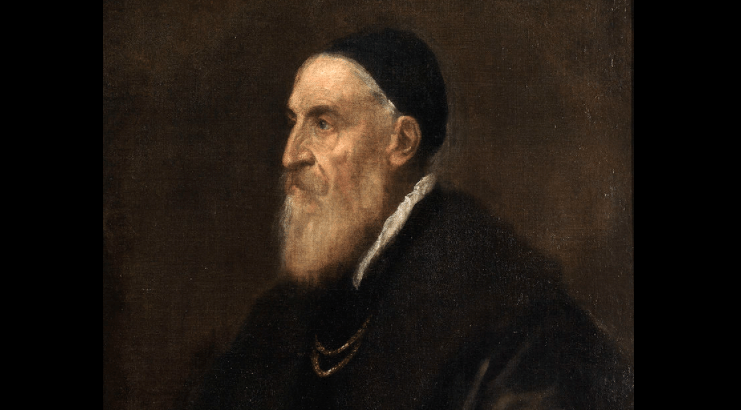
Source : wikipedia.org
In the early 1500’s Titian may have served an apprenticeship in the workshop of Giovanni Bellini, the greatest Venetian master of the preceding generation. Subsequently he may have studied with Giorgione, the radical innovator of the new era. It is known that in 1508 he worked as the junior collaborator with Giorgione on frescoes (now in fragments) for the facade of the Fondaco dei Tedeschi, the German merchants’ center in Venice. It is also known that he completed at least one canvas left unfinished by Giorgione at his death in 1510—Sleeping Venus (Gemäldegalerie, Dresden).
In 1511, Titian received payment for frescoes in the Scuola di Sant’ Antonio in Padua, his earliest securely datable extant work. He succeeded Bellini as official painter to the Venetian Republic after Bellini’s death in 1516.
In the following years Titian’s career prospered, and his fame spread beyond Venice. He worked for the courts of Ferrara, Mantua, and Urbino. In 1533 he was appointed court painter to the Holy Roman emperor Charles V, who conferred upon him the rank of Count Palatine as well as the Order of the Golden Spur. Titian was in Rome in 1545-1546 as a celebrated guest and was visited by Michelangelo. In 1547-1548 and again in 1550-1551, he attended the imperial court at Augsburg, where he met Charles’ son, the future Philip II of Spain, who became the most important patron of the elderly Titian. As customary, Titian ran a large studio, in which his son Orazio, others of his family, and outsiders assisted him.
In Venice, Titian reigned supreme. Not only was he the most honored painter of the century, but he was also a significant public personality, forming with the writer Pietro Aretino and the sculptor-architect Jacopo Sansovino a triumvirate that dominated the cultural life of the city.
Titian was not an intellectual, but his pictorial interpretations of literary themes are the most sensitive of the Renaissance. He was trained as a painter and never actually practiced any other art, yet his pictures contain sculptural images of his own design, and he was consulted as an expert in architecture. When he died in Venice on Aug. 27, 1576, his fellow Venetian painters planned a public funeral to match in pomp and ceremony the famous obsequies held for Michelangelo by the painters of Florence. This tribute was frustrated, however, by the disastrous plague that was then raging through Venice.
Stylistic Periods.
Modern critics have tended to distinguish six phases in the development of Titian’s style—a rhythmic system somewhat arbitrary but useful in charting the course of the artist’s long career. During the first phase, running to 1516, Titian’s style evolved from the soft, poetic traditions of Bellini and Giorgione. His figures assumed a more powerful stature than those of his predecessors, as in the frescoes in Padua and in Sacred and Profane Love (c, 1515; Borghese Gallery, Bome ).
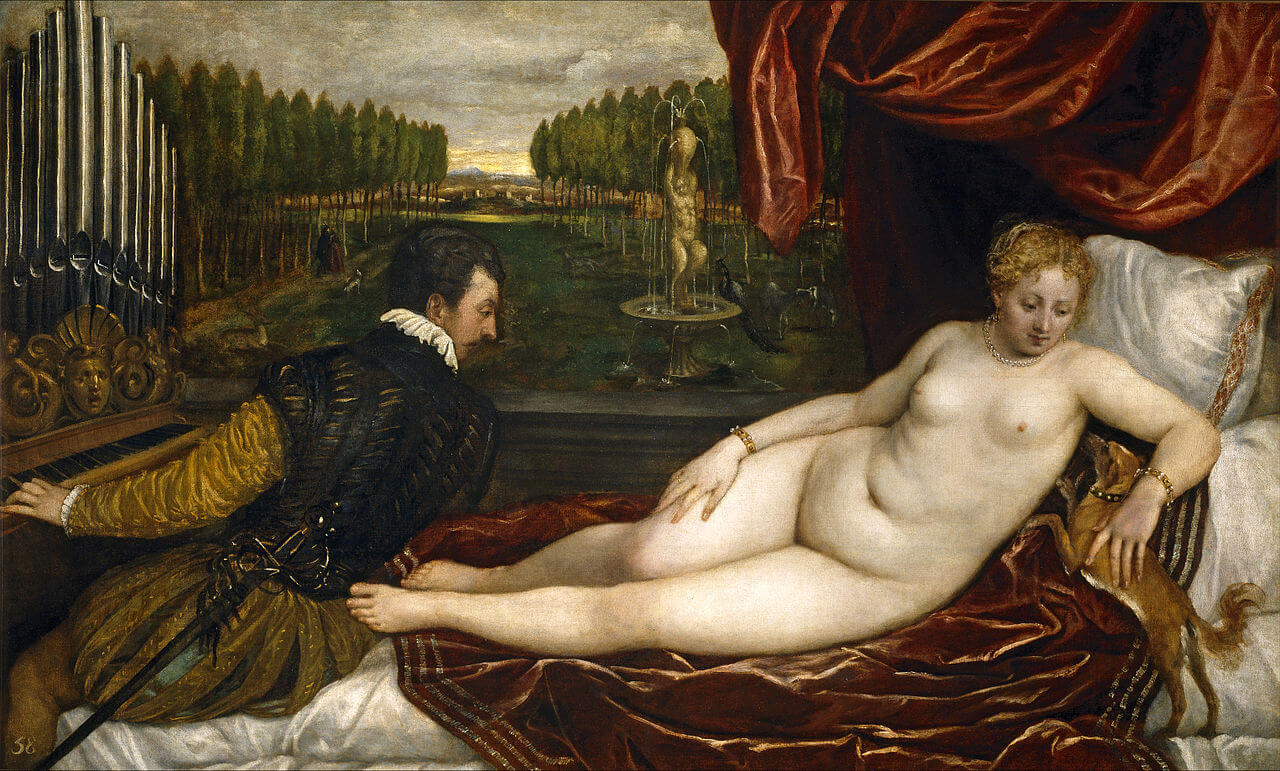
Venus and Organist and Little Dog, c. 1550. Museo del Prado, Madrid. (Source : wikipedia.org)
The second phase,
from 1516/1518 to about 1530, includes a series of monumental altar-pieces, beginning with the Assumption of the Virgin (1516-1518) in the Church of the Frari, Venice. The series continues with the Madonna of the Pesaro Family (1519-1526), also in the Frari, and culminates in the Death of St. Peter Martyr (1528-1530), destroyed by fire, for the Church of Santi Giovanni e Paolo, Venice. During these years (1518-1523) Titian also painted three mythological subjects for Alfonso d’Este, Duke of Ferrara—Worship of Venus ( Prado, Madrid ), Bacchanal of the Andrians (Prado), and Bacchus and Ariadne (National Gallery, London ). The second phase was a period of tremendous energy, with regard both to Titian’s own creative activities and to the character of the compositions themselves. Inspired by classical art and by Michelangelo and other painters of central Italy, Titian achieved a new type of heroic figure design. Further, he gained new control and inventiveness in his handling of color, which became a more dominant and integral element in his work.
The third phase,
from about 1530 to about 1540, is often considered a détente in Titian’s development. After the creative outburst of the preceding years, he is thought to have retired to a calmer, less dramatic state. This interpretation responds to the highly structured, rectilinear compositions of this decade and the emphasis on the more deliberate painting of natural forms, as in Venus of Urbino (1538; Uffizi, Florence) and Presentation of the Virgin ( 1534-1538; Acca-demia, Venice). During this period Titian also did portraits of such notables as Charles V with his dog (1532; Prado), Cardinal Ippolito de’ Medici (1533; Pitti, Florence), and Francis I (1538; Louvre, Paris).
In the fourth phase,
from about 1540 to about 1550, Titian was directly confronted with central Italian art, highlighted by his trip to Rome and his meeting with Michelangelo. These years were particularly critical, for now Titian measured his own achievements that emphasized color against the alternative aesthetic tradition of central Italy that stressed form, and he even tried at times to meet it on its own terms. His efforts may be seen in Cain and Abel, Sacrifice of Isaac, and David and Goliath, all between 1542 and 1544, now in the Church of Santa Maria della Salute, Venice. The most important portrait of this period was that of Charles V on horseback at the Battle of Muhlberg (1548; Prado).
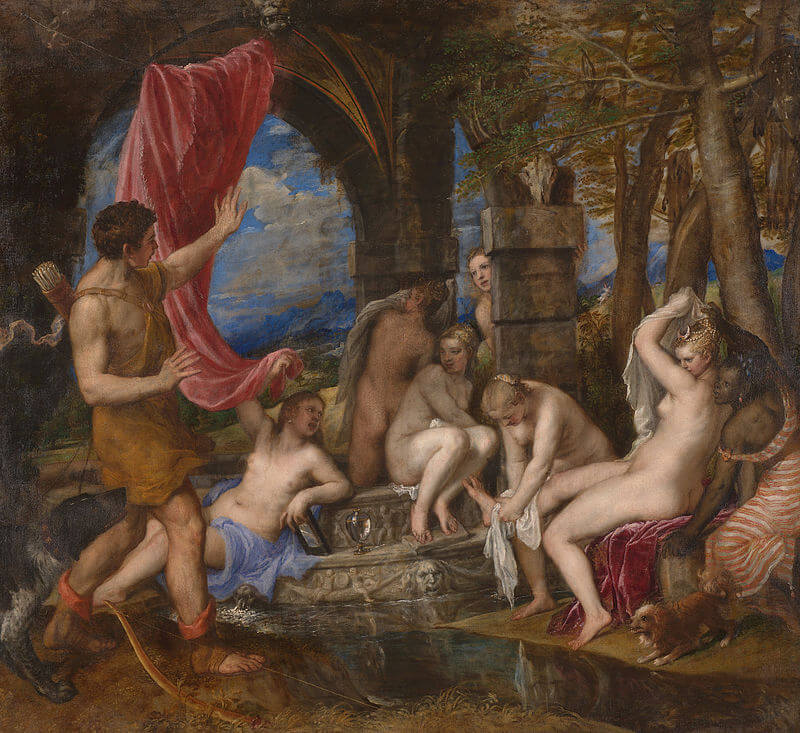
Diana and Actaeon (Source : wikipedia.org)
In the fifth phase,
1550 to 1560, Titian resolved the crisis between Venetian and central Italian styles, returning to his native tradition with new confidence and imagination. This is the period of the poesie, as Titian called them, for Philip II—pictorial poems combining dramatic action and sensuality, such as in Danaë ( 1554; Prado), Rape of Europa (1559; Gardner Museum, Boston), Venus and Adonis (versions in the Prado and elsewhere), and Venus and the Lute-player (c. 1560; versions in Fitzwilliam Museum, Cambridge, and Metropolitan Museum, New York).
The final phase, from about 1560 to his death, represents a recapitulation of Titian’s development but on a new level that was intimately related to his actual methods of painting at that time. Works from this period include the Martyrdom of St. Lawrence (Escorial), Adam and Eve (Prado), and the Pieta (Accademia, Venice). Titian planned the last for his own tomb.
Subject Matter.—Altarpieces.
Among the most impressive and influential of Titian’s early paintings are his altarpieces. According to reports, the huge size and scale of the Assumption of the Virgin created a stir within the conservative religious community and even among other painters. But the work was soon accepted as a masterpiece, declaring new directions and possibilities in painting. In this great panel the Virgin is borne aloft within a circular setting of heavenly radiance. Below, the Apostles form a corresponding rectangular block. The bold geometry of the design, related to Raphael’s contemporary altarpieces, offers a clear statement of the pictorial principles characteristic of the High Renaissance.
In the Madonna of the Pesaro Family, Titian established an unusual precedent in placing the Virgin and Child off the central axis. He took this step not purely to vary an old convention of centrality in altarpieces but also to accommodate the figures to different angles of vision. Such subtle concern for the relationship of a painting to its particular site and to the position of the viewer is typical of Titian.
In the Death of St. Peter Martyr the drama of the saint’s assassination is set within a landscape dominated by several monumental trees. The theme of figures; in a landscape, developed especially by Bellini, had been important in Venetian painting since the later 15th century. Its poetry was further explored by Giorgione, and Titian demonstrated its heroic potential. In the altarpiece the trees assume a significant role in the action itself, accentuating it by their positions within the composition and, in a sense, even participating in the drama through their own dynamic rhythms.
Mythological Compositions.
The relationship of figure to landscape is central to Titian’s art and is explored in many subjects, especially those from classical mythology that emphasize the reclining female nude. Giorgione’s Sleeping Venus offered a theme upon which Titian invented variations throughout his career. These extremely sensuous images celebrate in different ways the fullness of nature, the richness of the female form, and, in a more abstract sense, the concept of beauty itself. In the composition of Venus and the Luteplayer the introduction of the musician adds a significant dimension. Both the aural and visual perception of beauty are represented. The music of the lute fills the air as the naked form of Venus dominates the canvas. The concept of universal beauty has, of course, foundations in philosophical tradition. Titian, however, gave it tangible form by relating it to human experience, one of the great and influential achievements of his art.
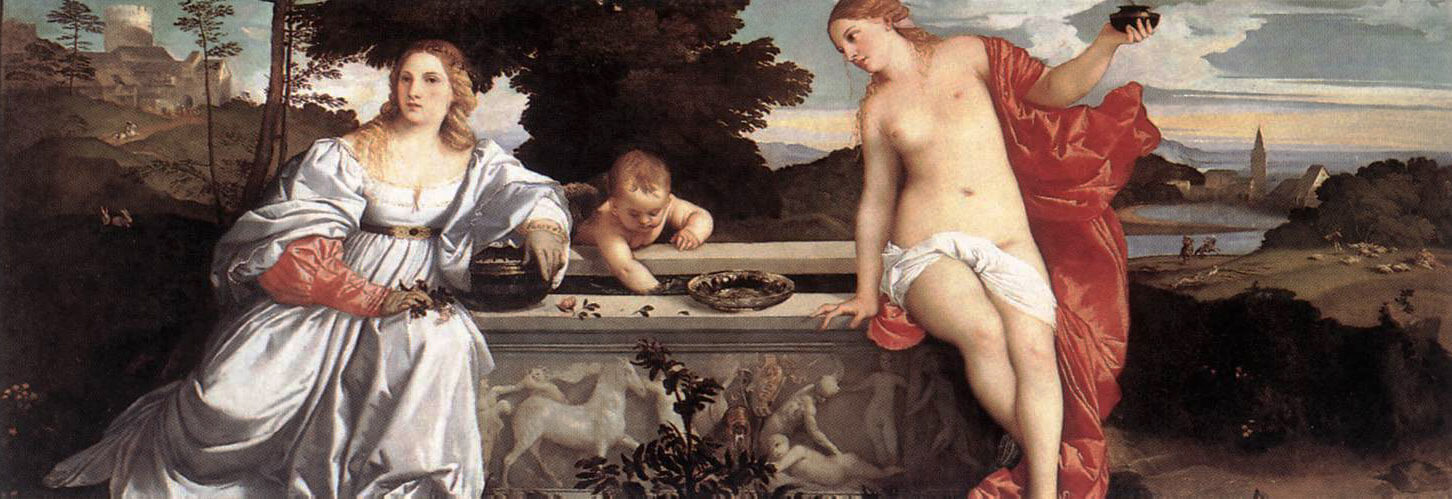
Sacred and Profane Love,1514, Galleria Borghese, Rome (Source : wikipedia.org)
In his treatment of mythological subjects Titian looked to classical sources. The Worship of Venus, Bacchanal, and Bacchus and Ariadne, all for Alfonso d’Este, are based on ancient texts and are in effect re-creations of classical works of art. The first two closely follow literary descriptions of specific lost Roman paintings. From such archaeological evidence, as it were, Titian created a vital world of natural forms and energies, a celebration of the gods of love and wine, of fertility and frenzy.
The poesie for Philip II were based mostly on Ovid’s Metamorphoses. But the painter did not merely illustrate the lines of the ancient poet. Rather, he imaginatively translated them into a new medium, in the process engaging in certain editing and revision. Thus, for example, in rendering the story of Venus and Adonis, he abandoned the text to redefine the dramatic high-point of the tale, the actual parting of the lovers, a situation absent from the poem.
Portraits.
It seems only natural that a painter of such dramatic insight should be a great portraitist as well. Titian endued his sitters with psychological profundity, and just this added dimension, shared to a degree only by Raphael among his contemporaries, elevates Titian above other Renaissance portrait painters. His figures are not set against backdrops, but instead, with softened forms and edges, seem to merge with their surroundings. The shadows playing over their features add an aura of privacy to their moods, and their hands never engage in meaningless or obvious gestures. This approach to the portrait as a psychological world of inner movement and illumination, prepared for by the examples of Leonardo da Vinci and Giorgione, was fully comprehended only by the artist who, more than any other, might be recognized as Titian’s heir—Rembrandt. In the monumental portraits of Charles V, above all the equestrian portrait, Titian established the basis for official baroque portraiture of the 17th century.
Technique.
One of Titian’s followers left a long description of the master’s working procedure toward the end of his life. According to this source, Titian began a painting by sketching the composition directly onto the canvas, using a loaded brush for the monochrome underpainting and establishing with just a few strokes the structures of the figures. He turned the picture to the wall for a period of weeks or even months, then scrutinized it critically, adjusted the composition, and corrected whatever faults he found. He repeated this procedure until he judged the canvas finished. In the final stages, Titian is said to have painted with his fingers as much as with the brush.
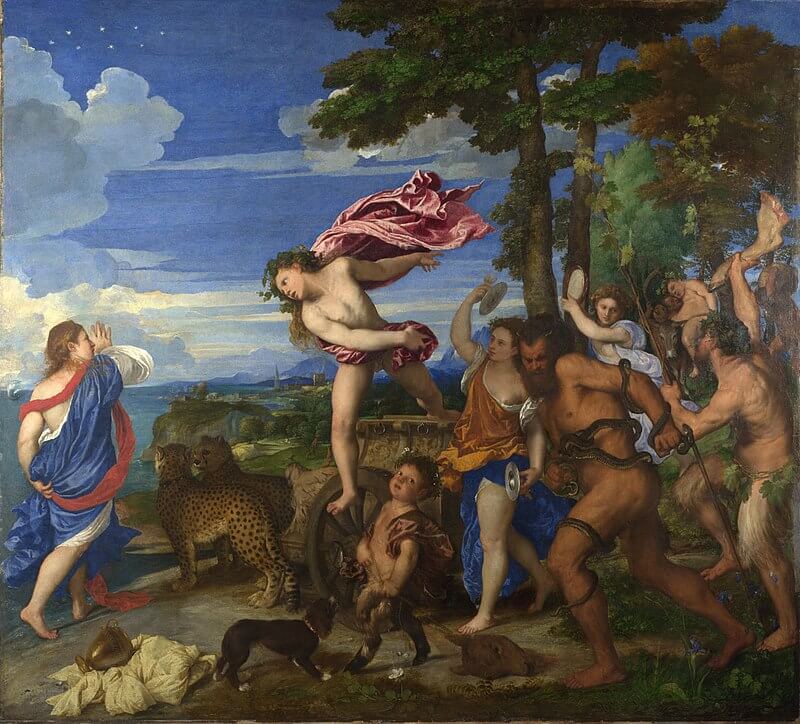
Bacchus and Ariadne, c. 1520–1523. National Gallery, London. (Source : wikipedia.org)
In recognizing Titian as a master colorist, his contemporaries and later critics were not thinking primarily of the purity, clarity, or intensity of his pigments but of his methods of applying paint. The free, open structure of the painted surface, composed of individual brushstrokes making patches of color, offered an approximation of reality rather than an absolute delineation of form. Much is left to suggest that a particular configuration of loosely applied colors requires the viewer to use his imagination to complete the image. Titian’s late works seem to speak directly of the painter’s medium and craft. On this level in particular they rank with the sculpture of Michelangelo as the most resonant creations of the Renaissance.